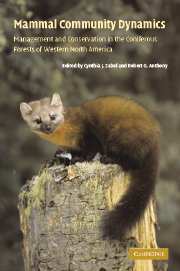 Mammal Community Dynamics
Mammal Community Dynamics Published online by Cambridge University Press: 15 December 2009
Introduction
Johnson (1980) provided a conceptual framework to describe habitat selection that identified four scales of selection: geographic range, home range, resource patches within home ranges, and specific resources necessary for survival (Fig. 16.1). The spatial scales over which these patterns of selection occur vary widely among species of mammals found in northwest coniferous forests. Harris (1984) estimated home range sizes for mammals in the Pacific Northwest and indicated they have a home range size distribution described by a negative exponential function (Fig. 16.2). Natural disturbance regimes common in Pacific Northwest coniferous forests (Spies and Turner 1999; Fig. 16.3) result in a distribution of patch sizes remarkably similar to this home range size distribution with frequent disturbances (sun flecks, small gaps, herbivores, and pathogens) creating small patches, and infrequent disturbances (fire, wind) creating larger patches. Indeed, inherent scales of disturbance in northwest coniferous forests under natural conditions likely represent the range of conditions and landscape mosaics that match evolved life histories of mammal species throughout the region. However, the effects of alterations in the spatial and temporal variability, pattern, and composition of the landscape caused by recent human disturbances, particularly timber harvest, raise questions regarding the continued persistence of diverse mammalian communities in managed forests (Lawlor 2003).
Landscapes are defined as the heterogeneous land area composed of an interacting mosaic of patches, at any scale, relevant to the phenomenon (e.g., species) under consideration (McGarigal and Marks 1995, McGarigal and McComb 1995).
To save this book to your Kindle, first ensure [email protected] is added to your Approved Personal Document E-mail List under your Personal Document Settings on the Manage Your Content and Devices page of your Amazon account. Then enter the ‘name’ part of your Kindle email address below. Find out more about saving to your Kindle.
Note you can select to save to either the @free.kindle.com or @kindle.com variations. ‘@free.kindle.com’ emails are free but can only be saved to your device when it is connected to wi-fi. ‘@kindle.com’ emails can be delivered even when you are not connected to wi-fi, but note that service fees apply.
Find out more about the Kindle Personal Document Service.
To save content items to your account, please confirm that you agree to abide by our usage policies. If this is the first time you use this feature, you will be asked to authorise Cambridge Core to connect with your account. Find out more about saving content to Dropbox.
To save content items to your account, please confirm that you agree to abide by our usage policies. If this is the first time you use this feature, you will be asked to authorise Cambridge Core to connect with your account. Find out more about saving content to Google Drive.